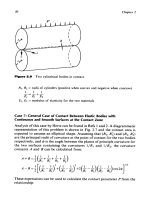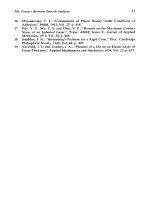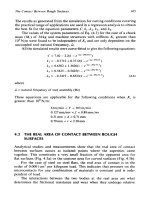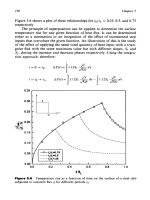Plastics Engineered Product Design Episode 1 pdf
Bạn đang xem bản rút gọn của tài liệu. Xem và tải ngay bản đầy đủ của tài liệu tại đây (611.89 KB, 28 trang )
I
auct
w
tosatc
&
Donalc
2
ELSEVIE
Plastics
Engineered
Product
Design
Dominick Rosato and
Donald Rosato
ELSEVIER
UK
USA
JAPAN
Elsevier Ltd, The Boulevard, Langford
Lane,
Kidlington, Oxford
OX5
lGB,
UK
Elsevier Inc, 360 Park Avenue South, New
York,
NY
10010-1710,
USA
Elsevier
Japan, Tsunashima
Building
Annex,
3-20-12
Yushima, Bunkyo-ku, Tokyo
113,
Japan
Copyright
0
2003 Elsevier Ltd.
All
rights
reserved. No part of
this
publication may be reproduced, stored in a retrieval system
or
transmitted
in
any
form
or
by any means: electronic, electrostatic, magnetic tape, mechanical,
photocopying, recording
or
otherwise, without permission in writing from the publishers.
British
Library
Cataloguing
in
Publication
Data
Rosato, Dominick V.
Plastics engineered product design
1.Plastics 2.Engineering design %.New products
I.Title ILRosato, Donald V. (Donald Vincent), 1947-
620.1’923
ISBN
1856174166
No
responsibility
is
assumed by
the
Publisher for any injury and/or damage
to
persons
or
property as a matter
of
products liability, negligence
or
otherwise,
or
from any
use
or
operation
of
any methods, products, instructions
or
ideas contained in the material herein.
Published by
Elsevier Advanced Technology,
The Boulevard, Langford
Lane,
Kidlington, Oxford
OX5
lGB, UK
Tel: +44(0) 1865 843000
Fax:
+44(0)
1865 843971
Typeset by Land
&
Unwin, Bugbrooke
Printed and bound
in
Great Britain by Biddles Ltd, Guildford and King’s
Lynn
Contents
Preface,
Acknowledg-ement
About the Authors
Chapter
1
OVERVIEW
Introduction
Materials
of
construction
Thermoplastics
Crystalline
&
Amorphous Polymers
Liquid Crystalline Polymers
Thermosets
Crosslinked Thermoplastics
Reinforced Plastics
Thermal Expansions
Ductilities
Toughness
Tolerances/Shrinkages
Compounds
Prepregs
Sheet Molding Compounds
Bulk Molding Compounds
Commodity
&
Engineering Plastics
Elastomers/Rubbers
Morphology/Molecular Structure/Mechanical
Plastic behaviors
Property
Densities
Molecular Weights
Molecular Weight Distributions
Viscosities and Melt
Flows
Newtonian/non-Newtonian
Xlll
xvii
1
1
5
10
11
12
13
15
15
17
17
18
18
18
19
19
19
20
20
21
22
22
23
23
23
24
iv
Contents
Melt Index
Viscoelasticities
Glass Transition Temperatures
Melt Temperatures
Drying Operations
Rheology
&
Mechanical Analysis
Processing-to-Performance Interface
Processing and Moisture
Fabricating processes
Orientations
Postformings
Coexuusions
Coinjections
Gas-Assist Moldings
Micromoldings
Blow Moldings
Complex Consolidated Structural Products
Extrusions
Injection Moldings
Thermoformings
Foams
Reinforced Plastics
Calenders
Castings
Coatings
Compression Moldings
Reaction Injection Moldings
Rotational Moldings
Variables
FALL0
approach
Chapter
2
DESIGN
OPTIMIZATION
Introduction
Terminology
Engineering Optimization
Design Foundation
Problem/Solution Concept
Design Approach
Model
Less
Costly
Model Type
Design Analysis Approach
Computer
Sohare
Viscoelasticity
24
25
26
26
26
28
29
30
31
33
34
34
34
35
35
36
37
37
38
39
40
40
41
41
42
42
42
43
44
44
46
46
46
57
58
61
62
62
63
64
64
65
Contents
v
Polymer Structure
Viscoelasticity Behavior
Summary
Relaxation/Creep Analysis
Viscosity
Rheology and mechanical properties
Static stress
Hooke’s
Law
Tensile Stress-Strain
Modulus of Elasticity
Flexural Stress-Strain
Compressive Stress-Strain
Shear Stress-Strain
Torsion Stress-Strain
Direct Load Shear Strength
Residual Stress
Dynamic/Static Mechanical Behavior
Energy and Motion Control
Dynamic stress
Isolator
Torsion Load
Rapid loading
Impact
Impulse
Puncture
Friction
Erosion
Hydrostatic
Cavitation
Rain
High performance
Reinforced Plastic
Orientation of Reinforcement
Orientation Terms
Basic Design Theory
Fiber Strength Theory
Fiber Geometry on Strength
Stiffness-Viscoelasticity
Creep
and
Stress Relaxation
Conceptual design approach
Design Analysis
Pseudo-Elastic Method
Theory of Combined Action
67
67
68
70
71
73
74
75
76
78
80
83
84
86
86
87
88
89
91
92
97
101
102
104
105
106
109
109
110
111
113
113
115
115
116
120
126
129
129
130
130
132
135
vi
Contents
Overview
Stress-Strain Analysis
Plain Reinforced Plates
Composite Plates
Rending of Beams
and
Plates
Structural Sandwiches
Stiffness
Stresses in Sandwich Beams
Axially-Loaded Sandwich
Filament-Wound Shells, Internal Hydrostatic
Pressure
Basic Equations
Weight of Fiber
Minimum Weight
Isotensoid Design
Geodesic-Isotensoid Design
Chapter
3
DESIGN
PARAMETER
Load determination
Design analysis process
Reinforced Plastic Analysis
Stress Analysis
Stress-strain behavior
Rigidity
(EI)
Hysteresis Effect
Poisson’s Ratio
Brittleness
Ductile
Crazing
Stress Whitening
Surface Stresses
and
Deformations
Combined stresses
Creep
Fatigue
Reinforcement performance
Chapter
4
PRODUCT
DESIGN
Introduction
Reinforced Plastic
Monocoque Structure
Geometric shape
Modulus of Elasticity
E1
theory
135
136
139
144
151
154
154
155
156
157
157
158
159
159
159
161
161
165
167
168
170
170
171
172
173
1 74
1 74
177
177
178
180
189
195
198
198
200
202
202
203
203
Contents
vii
Plate
Beam
Rib
Folded Plate
Plastic
Reinforcedfloamed Plastic
Euler’s Formula
Column
Torsion
Sandwich
Gear
Bearing
Grommet
Gasket
Shape
Design
Contact Stress
PV
Factor
Overview
Filament Wound Shape
Netting Analysis
Cylinder
Sphere
Tank
Fabricating
RP
Tank
Underground Storage Tank
Hopper
Rail
Car Tank
Highway
Tank
Very Large Tank
Corrosive Resistant
Tank
Pipe
Thermoplastic Pipe
RP
Pipe
Leaf Spring
Special Spring
Cantilever Spring
Torsional Beam Spring
Spring
Hinge
Press
fit
Snap
fit
Tape
Packaging
204
207
209
211
211
213
216
218
220
222
223
230
234
2 34
235
235
237
237
237
238
239
24
1
243
244
244
245
249
254
254
254
256
256
257
263
264
273
274
275
276
277
278
280
283
viii
Contents
Permeability
Cushioning
House
of
the
Future
House Top
Transportation
Automobile
Truck
Aircraft
Marine Application
Building
Boat
Underwater Hull
Missile and Rocket
Electrical/Electronic
Shielding Electrical Device
Radome
Surgical Product
Dental Product
Health Care
Medical
Recreation
Appliance
Furniture
Water filter
Lumber
Metal
Metal Replacement
with
Plastic
Performance Behavior
Moisture Effect
Long Term
vs.
Short Term Loading
Stress
Concentration
Coefficient
of
Expansion
Bolt
Torque
Effcct
Impact Barrier
Vehicle Oil
Pan
Attachment
Design limitation and constraint
Chapter
5
COMPUTER-AIDED
DESIGN
Technology overview
Computers and people
Geometric modeling
Design accuracy and efficiency
285
287
289
29
1
293
295
306
307
307
311
311
312
313
315
316
318
320
322
322
324
324
325
326
329
330
331
3 32
333
334
334
336
337
337
339
340
340
34 1
344
344
346
347
349
Contents
ix
Chapter
6
Input/output device
Sofnvare
Central Process Unit
Programs
Database/General Information
Supply Chain Sofnvare
Application
Designing
Graphics
Structural Analysis
Sofnvare Analysis
Finite element analysis
Synthesizing design
CAD special use
Optimization
CAD Prototyping
Rapid Prototyping
CAD standard and translator
Data sharing
Engineered personal computer
CAD editing
CIM changing
Computer- based training
IBM advances computer
Artificial intelligence
Plastic Toys-Smart computer
Computer devices via
DNA
Design via internet
PLASTIC PERFORMANCE
Overview
Influencing Factor
Selecting plastic
Comparison
Worksheet
Thermal Property
Thermal Expansion/Contraction
Hyperenvironment
Flammability
Steel
and
Plastic
Test
Temperature
Thermal Conductivity
351
351
351
353
355
360
360
361
362
364
364
365
366
368
368
369
370
371
372
373
374
375
375
376
376
377
377
379
381
381
384
385
387
393
393
396
400
400
402
406
406
407
x
Contents
Chapter
7
Smoke
Electrical/Electronic
Corrosion resistance
Chemical resistance
Friction
Tolerance
Limit
Processing Effect
Recycled plastic
Engineering data information source
Publication
Industry Societies
Encyclopedia and Industrial Books
Standards
Engineering Information
Information Broker
Engineering Societies and Associations
Designs
Databases
Websites
Training programs
Thomas Register
DESIGN
RELIABILITY
Testing
Classiflmg
Test
Laboratory
Quality control
Quality and Reliability
Total Quality Management
Quality and Design
Statistics
Testing;
QC,
statistics, and people
Product failure
Spectrum Loading and Cumulative Damage
Crack Growth and Fracture Mechanics
Fatigue and Stress Concentration
Fatigue Loading and Laboratory Testing
Predicting Long Time Reliability
Meaning of data
Safety factor
Safety Factor Example
409
410
41
1
412
413
414
415
41 8
42
1
424
425
426
428
428
429
430
43
1
43
1
432
432
432
434
439
440
444
445
446
446
446
448
448
450
450
454
455
456
456
458
459
459
460
Contents
xi
Chapter
8
SUMMARY
Overview
Market Size
Customer
Constraint
Responsibility
Responsibility Commensurate with
Ability
Risk
Acceptable
Risk
Predicting Performance
Design Verification
Perfection
Ethics
Ergonomic
Costing
Technical Cost Modeling
Engineering
and
law interface
Plastic material
Design demand
Plastic success
Future
Appendix A
ABBREVIATIONS
Appendix
B
GLOSSARY
464
464
465
466
466
467
467
468
468
469
470
470
471
471
472
473
474
476
477
478
479
480
493
Appendix
C
TRADENAMES
547
BIBLIOGRAPHY
555
xiv
Preface. acknowledgement
material selection for end
use
applications where factors such as
thermal, chemical, electrical, optical, and environmental properties are
important. The mechanical engineer will also gain an understanding of
the manufacturing constraints imposed by mold and die designs as well
as
the
processes used
to
manufacture plastic products. The plastic
engineer will gain a better understanding of the principles of stress
analysis, failure modes in structures, and the
use
of computer based
finite element methods for in depth stress and deformation calculations.
This book will provide the means that both can expand their expertise
from the synergistic effect of combining both disciplines.
This book will provide many fundamentals with their required details
so
that the reader can become familiar and put
to
use
the different design
approaches. Reviews relate
to
fabricating over
35,000
plastics available
worldwide
to
produce the many millions
of
different products
that
are
used worldwide.
Information is concise and comprehensive. Engineering and non-
engineering principles reviewed have been in
use
worldwide and are
published in many different forms that are included in the bibliography.
The book also lists commercial software sources as well as material
databases. The reader, with or without design or engineering
experience, can understand these principles.
It
will be invaluable
to
the
most experienced designers or engineers, as well as providing a firm
basis for the novice. It meets the designer’s goal that is essentially an
exercise in predicting product performances.
Its
unique approach will expand and enhance your knowledge of plastic
technology. Plastic ranges of behavior are presented to enhance one’s
capability in fabricating products
to
meet different performances, low
cost requirements, and profits. Important basic concepts are presented
such as understanding the advantages of different materials and product
shapes. This full presentation provides the background needed
to
understand performance analysis and the design methods useful to the
designer.
It
provides an important tool for approaching the target “get-
to-market-right-the-first-time.”
Patents or trademarks may cover information presented.
No
authorization
to
utilize these patents or trademarks is given or implied;
they are discussed for information purposes only. The
use
of general
descriptive names, proprietary names, trade names, commercial
designations, or the like does not in any way imply that they may be
used freely.
A
practical approach
was
used
to
obtain the information contained
in
this book. While information presented represents
useful
information
Preface, acknowledgement
xv
that can be studied or analyzed and is believed
to
be true and accurate,
neither the authors nor the publisher can accept any legal responsibility
for any errors, omissions, inaccuracies,
or
other factors.
The
authors
and contributors have taken their best effort
to
represent
the
contents
of
this
book correctly.
In
preparing this book
to
ensure its completeness and the correctness of
the
subjects reviewed,
use
was made of the authors’ worldwide
personal, industrial, and teaching experiences totaling about a century.
Use
was also made of worldwide information from industry (personal
contacts, material
and
equipment suppliers, conferences, books, articles,
etc.) and major trade associations.
The
authors have taken their best
effort
to
represent the contents of
this
book correctly.
The
Rosatos
2003
ACKNOWLEDGEMENT
Special and usehl contributions
in
preparing most of the figures and
tables in this book were provided by David
P.
DiMattia. David is an
experienced graphics art director specializing in marketing, product
promotion, advertising, and public relations.
He
handles
the
design
and
production services for a number of consumer and business-to-business
accounts.
xviii
About
the
authors
written extensively, developed numerous patents within
the
polymer
related industries,
is
a
participating member of many trade and industry
groups, and currently is involved in
these
areas with PlastiSource, Inc.,
and Plastics FALLO. Received BS in Chemistry from Boston College,
MBA
at
Northeastern University, M.S. Plastics Engineering from
University of Massachusetts Lowell (Lowell Technological Institute),
and Ph.D. Business Administration
at
University of California, Berkeley.
2
Plastics Engineered Product Design
11.
short to very long service life, degradable
to
non-degradable,
12.
process virgin with recycled plastics or recycled
alone,
13.
simple
to
complex shapes including many that are difficult or
impossible to form with other materials,
14.
breathable film for
use
in horticulture,
15.
heat
and
ablative resistance,
16. andsoon.
There is a plastic for practically any product requirements, particularly
when not including cost for a few products.
One
can say that if plastics
were not
to
be used it would be catastrophic worldwide for people,
products, communications, and
so
on
with
a
major economic crisis
because much more expensive materials and processes would be used.
Materials can be blended or compounded
to
achieve practically any
desired property or combination of properties. The final product
performance is affected by interrelating the plastic with its design and
processing method. The designer’s knowledge of all these variables is
required otherwise it can profoundly affect the ultimate success or
failure of a consumer or industrial product.
When
required the designer
makes
use
of others
to
ensure product success.
Plastic plays a crucial and important role in the development of our
society worldwide. With properties ranges that can be widely adjusted
and ease of processing, plastics can be designed
to
produce simple
to
highly integrated conventional and customized products. While it is
mature,
the
plastics industry is far from having exhausted its product
design potential. The worldwide plastics industry offers continuous
innovations in plastic materials, process engineering, and mechanical
engineering design approaches that will make
it
possible
to
respond
to
ever more demanding product applications (Fig. 1.1).
Innovation trends emerging in plastics engineering designs are
essentially combinations and improvements of different processes,
combinations and improvements of different materials, integration of
a
wide range of functions within a single product, reduced material
consumption, and recyclability of the materials employed. At the same
time, rising requirements are being placed
on
design efficiency, product
quality, production quality, and part precision, while costs are expected
to
be reduced wherever possible. This combination of objectives is
achievable
by factors such as process-engineering innovations that
reduce the number of process steps.
The basic and essential design exercise in product innovation lies
in
predicting performances. This includes the process of devising
a
product that fulfills the total requirements of the end user and satisfies
1
-Overview
3
Figure
1
.I
Flow-chart from raw materials to products (Courtesy of Plastics
FALLO)
the needs of the producer in terms of
a
good return on investment
(ROI).
The product designer must be knowledgeable about all aspects
of plastics such as behavioral responses, processing, and mechanical and
environmental load
stresses.
Product loads range from short-time static,
such
as
tensile, flexural, torsion, etc., to long time dynamic, such as
creep, fatigue, high speed loading, motion control, and
so
on.
In
this
book, plastics design concepts
are
presented that can be applied
to
designing products for
a
range of behaviors.
An
inspired idea alone will not result in
a
successful design. Designing
is,
to
a
high degree, intuitive and creative, but at the same time
empirical and technically influenced. Experience plays an important part
that
requires keeping up to date on the endless new developments in
materials and processes.
An
understanding of one’s materials and
a
ready acquaintance
with
the relevant processing technologies
are
essential for converting an idea
to
an actual product. In addition,
certain basic tools are needed, such
as
those for computation and
measurement and for testing of prototypes and/or fabricated products
to
ensure that product performance requirement
are
met.
A
single
individual designer may not have all of these capabilities
so
inputs from
many reliable people and/or sources are required.
4
Plastics Engineered Product Design
Inputs from many disciplines, both engineering and non-engineering,
may be required when designing
a
product such as
a
toy,
flexible package,
rigid container, medical device, car, boat, underwater device, spring, pipe,
building, aircraft, missile, or spacecraft. The conception of such products
usually requires coordinated inputs
from
different specialists. Input may
involve concepts of man-machine interfaces (ergonomics), shape, texture,
and color (aesthetics). Unless
these
are in balance, the product may fail
in the market place. The successhl integrated product is the result of
properly collecting all
of
the required design inputs.
While plastic product design can be challenging, many products seen in
everyday life may require only
a
practical, rather than rigorous approach.
They are not required
to
undergo sophisticated design analysis because
they
are
not required
to
withstand high static and dynamic loads
(Chapter
2).
Their design may require only the materials information in
conventional data sheets from plastic material suppliers. Examples
include containers, cups, toys, boxes, housings for computers, radios,
televisions, electric irons, recreational products, and nonstructural or
secondary structural products of various kinds like the interiors in
buildings, automobiles, and aircraft. The design engineer will need
to
know when
to
use
the practical approach, the rigorous approach, or
a
combination approach.
Plastics do not only have advantages but
also
have disadvantages or
limitations. Other materials (steel, wood,
etc.)
also
suffer with dis-
advantages or limitations. Unfortunately there is no one material
(plastic, steel, etc.) that can meet all requirements thus these limitations
or faults are sometimes referred
to
incorrectly as disadvantages. Note
that the faults of materials known and utilized for hundreds of years are
often overlooked; the faults of the new materials are often over-
emphasized.
Iron and steel are attacked by the elements of weather and fire [SlS'C
(1
500"F)I
but the common practice includes applying protective
coatings (plastic, cement, etc.) and then forgetting their susceptibility
to
attack is all
too
prevalent. Wood is a
usehl
material yet who has not
seen a rotted board, wood
on
fire, etc. There is cracked concrete and
so
on.
Rcgardless of
these
and many other disadvantages, lack of perfection
does not mean that any steel, wood, or concrete should not be used.
The same reasoning should apply
to
plastics. In many respects, the
gains
made with plastics in
a
short span of time far outdistance the
advances made in these other materials.
Recognize that modern design engineering has links with virtually every
technical area; material, mechanical, electrical, thermal, processing, and
6
Plastics Engineered Product Design
fable
1
.I
Examples
of
stages
in
plastic
manufacturing
Basic Chemicals
Petroleum
is
converted to petrochemicals such
as
ethylene, benzene, propylene and
Acetylene.
Monomers
Petrochemicals plus other chemicals are converted into monomers such
as
styrene,
ethylene, propylene, vinyl chloride, and acrylontrile.
Polymerization
One or more monomers are polymerized to form polymers or copolymers such as
polyethylene, polystyrene, polyvinyl chloride, and polypropylene.
Compounding
Additives, fillers, and/or reinforcements are mixed with polymers (referred to as plastics)
providing different properties and/or different fabricating methods for plastics. Hundreds
of
different materials are used such as heat stabilizers, color pigments, antioxidants,
inhibitors, and fire retardants.
Processing
Plastics
are
formed into different shapes such
as
sheets, films, pipes, buckets, primary and
secondary structures (boats, cars, airplanes, bridges,
etc.),
toys, housings, and many
thousand more products. Basically heat and pressure
are
used to shape these products
that usually are in finished form. Processes used include extrusion, injection molding,
blow molding, thermoforming, compression molding, spraying, rotational moldings,
reaction injection molding, and filament winding.
Finishing
In certain applications
a
finishing step is required
on
the fabricated part such as printing,
bonding, machining, etc.
curing was accurately used for
TSs.
At that time
TSs
represented
practically
all
the
plastic used worldwide. Thus
TPs
took on the
incorrect term curing even though there
is
no
chemical reaction
or
curing action.
Appreciate the polymer chemist’s ability
to
literally rearrange the
molecular structure of the polymer
to
provide an almost infinite variety
of compositions that differ in form, appearance, properties, cost, and
other characteristics. One must also approach the subject with
a
completely open mind that will accept
all
the contradictions that could
make it difficult
to
pin common labels on the different families of
plastics or even on the many various
types
within
a
single family that are
reviewed in
this
book.
Each plastic
(of
the
35,000
available) has specific
performance and processing capabilities.
1
-
Overview
7
Figure
1.2
Use of plastics in recreational products range from unsophisticated types to high
performance types such boats (Courtesy of Plastics
FALLO)
8
Plastics Enqineered Product Design
Boeing
777
uses different types of plastics that include high performance
reinforced plastics
,Nose
radome
Wing
foted
leading
edge
Win@to$ody fairing
sbut
forward and afl fairings
Outboard aileron
Flap
track
fainng
Floor
beams
I
Leading-and
/
ttailingedge panels
//
\
Elevator
Rudder Fintorquebox Stabiliuer toque
box
There are many different routes that the starting materials for plastics
can take on the way
to
the user. In
this
book,
we
are concerned with
those plastics that are supplied
to
the processor in the form of granules,
powder, pellets, flake, or liquids and in turn they are transformed into
plastic products. However, the same starting materials used
to
make
these plastics can take other routes and end up in the textile industry
(nylon fibers share common roots with a molded nylon gear; acrylic
fibers share common roots with acrylic sheet for glazing; etc.), paint
industry, adhesives industry, and other industries meeting their special
requirements.
Worldwide
total
plastic consumption is over
154
million ton
(340
billion lb) with about
90wt%
thermoplastics
(TPs)
and
10%
thermoset









